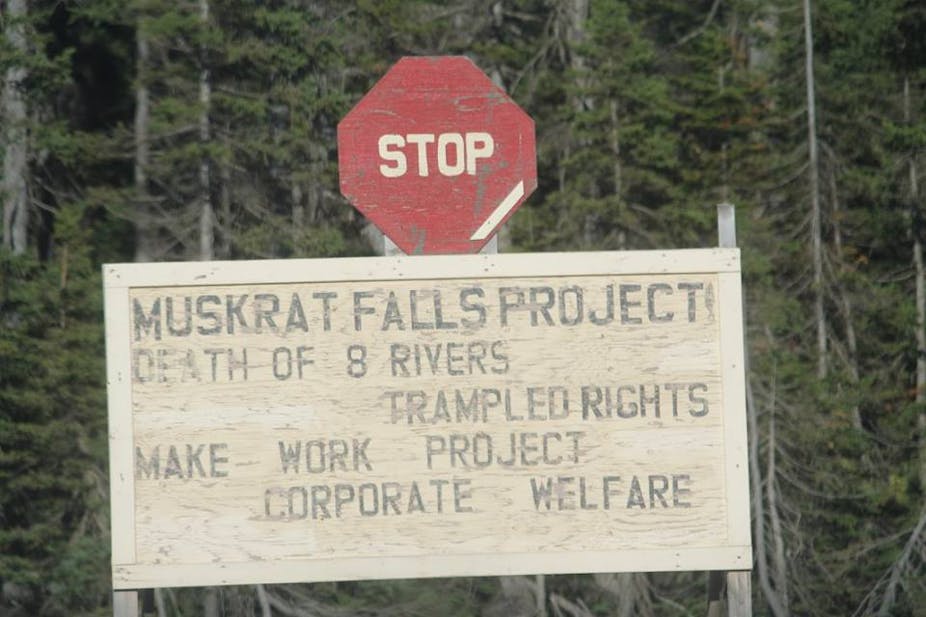A controversial hydroelectric dam project in sub-Arctic Canada relies on local Innu people giving up their own lands. Nalcor Energy, the firm building two dams to produce the Muskrat Falls hydroelectric project in Labrador, along Canada’s north-eastern coast, talks enthusiastically about “boundless energy”. And why not? Hydroelectric power is seen as a renewable and relatively benign way to meet the ever-growing energy needs of industrialised societies. Nalcor, owned by its provincial government, says that its project will “significantly reduce greenhouse gas emissions – equivalent to taking 3.2m vehicles off the road each year”.
This sounds great. Yet beyond the impressive feats of engineering and the CAN$11 billion cost (£6.5 billion), what will it take to accomplish what is being imagined here?
Across the world, many areas sacrificed for hydroelectric generation belong to indigenous or land-based peoples who either have to be moved or live with drastic changes. The Three Gorges dam in China displaced 1.2m people and the Belo Monte dam in Brazil could displace up to 40,000. And back in the 1950s the Kariba dam project on the Zambesi river in Zambia precipitated an involuntary resettlement of some 57,000 people, including the Gwembe Tonga farmers and hunters, whose homes, gardens, burial and spiritual sites were flooded with virtually no consideration from the British colonial authorities.
Opposition to “progress” may lead to imprisonment and in the case of Honduras and Guatemala, even to the suspected murder of indigenous opposition leaders and protesters.
This land was made for you and me
Canada is a supposed world leader on human rights. Yet any country staking its economy upon energy production on the lands of indigenous peoples is likely at some level to disregard their rights.
I have researched this over the past 20 years. Muskrat Falls is being constructed on the culturally important Mishta-shipu (“Big River”) on lands where there has been no treaty and which remain under unextinguished Aboriginal Title. The lands belong to the Innu peoples of the Labrador-Quebec peninsula. Yet Canadian authorities are proceeding with the project as they anticipate the Innu electorate will at some time in the future vote to extinguish ownership of their own land.

Contrary to standards in the UN Declaration on the Rights of Indigenous Peoples on free, prior and informed consent, the Innu are given few meaningful choices other than to relinquish their lands.
Under the current land claims process they must either extinguish their aboriginal and land rights or, under the notorious certainty provision, agree not to exercise those rights. In the short-term, many Innu may enjoy some extra cash, self-government rights and business opportunities, but they will have to accept having most of their collective lands privatised.
It’s not just me saying this: even the UN has been concerned for some time about the ease with which indigenous lands in Canada have been usurped. As recently as last year the Human Rights Council urged Canada to reconsider its process for consultation and consent.
“Consent” in Canada is based on the mind-numbingly complex New Dawn Land Claims Agreement-in-Principle. Although the Innu Nation negotiating team contests the agreement, many Innu do not know its contents. On a recent visit earlier this year to the Innu villages, I found that only four of the 30 Innu adults I consulted had read any of the text. Previous trips also revealed little knowledge of the important provisions in the agreement. But the agreement to extinguish their ownership rights doesn’t really matter because the mega-project is a fait accompli.
Who benefits? Not the locals
An environmental study commissioned by Nalcor downplayed the negative environmental effects of Muskrat Falls. The company admits that the dam will increase levels of toxic methylmercury in water and plankton but claims it will remain “in the natural ranges observed for lakes and rivers”. A subsequent modelling study by Harvard researchers predicted much higher concentrations of methylmercury in the waters surrounding Innu and neighbouring Inuit communities and predicted that “increases in methylmercury concentrations resulting from flooding associated with hydroelectric development will be greater than those expected from climate change”.

For people who continue to rely on fishing, this is shattering. A number of Innu and their supporters, alarmed by the likely impact, have now called for a complete rethink. They have organised protests at the site, where five Innu were dragged away, arrested and charged by police.
Nalcor says the dam will bring stable electricity prices, clean energy and jobs. But though the jobs brought to the nearby Innu community of Sheshatshiu provided a quick injection of cash they also increased existing community problems. People there told me cocaine and alcohol abuse have increased because of the high pay and shift work patterns at Muskrat Falls, along with subsequent family destabilisation and child neglect. This adds to endemic health problems such as high diabetes and suicide rates that are 14 times higher than the Canadian average. Community infrastructure remains terrible – one village even lacks drinkable water.
The very high costs of living in Labrador have always been offset by subsistence hunting, fishing and gathering, but with Muskrat Falls now joining a network of other hydroelectric projects spanning Innu territories across the Labrador-Quebec peninsula, the continual violation of their rights is increasingly imperilling their ability to enjoy healthy and sustainable lifestyles. While international attention focuses on the trampling of indigenous rights in developing countries, we should not forget that Muskrat Falls joins a long history of dispossession in North America.

